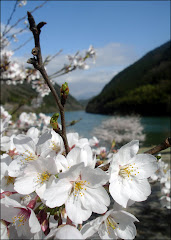Kyoto Rewind 2008: April 3, 2008

A view of the great gate of Nanzen-ji through a lacey veil of cherry blossoms. Nanzen-ji, or the Southern Mountain Temple, is thought to be the most famous and important Zen temple in the world.
 Located just outside of Heian Shrine, Okazaki Canal connects the Lake Biwa Canal network with the Kamo River.
Located just outside of Heian Shrine, Okazaki Canal connects the Lake Biwa Canal network with the Kamo River.
 A ride on a the canal is a great way to view the cherry blossoms.
A ride on a the canal is a great way to view the cherry blossoms.
 Walking the streets of Kyoto, somewhere in between the grounds of Nanzen-ji and the Philosopher's Path.
Walking the streets of Kyoto, somewhere in between the grounds of Nanzen-ji and the Philosopher's Path.
 This stoney, sakura-lined path leads to the gate of a private residence we stumbled upon as we wandered towards the Philosopher's Path.
This stoney, sakura-lined path leads to the gate of a private residence we stumbled upon as we wandered towards the Philosopher's Path.
 The entire estate was well hidden, surrounded by a wall offering only a glimpse of gardeners grooming the highest branches of the pine trees, shaded by magnificent clouds of cherry blossoms.
The entire estate was well hidden, surrounded by a wall offering only a glimpse of gardeners grooming the highest branches of the pine trees, shaded by magnificent clouds of cherry blossoms.
 Peaking over the low hedges encircling the entrance.
Peaking over the low hedges encircling the entrance.
 Bamboo blinds and cherry blossoms provide shade and shelter.
Bamboo blinds and cherry blossoms provide shade and shelter.
 The philosopher himself!
The philosopher himself!
 Absolutely one of the best places for hanami I've experienced so far. Highly recommended!
Absolutely one of the best places for hanami I've experienced so far. Highly recommended!
 A young girl in kimono smiles beneath the canopy of blossoms covering the path.
A young girl in kimono smiles beneath the canopy of blossoms covering the path.
 A couple admires the blossoms.
A couple admires the blossoms.

The palette of spring paints the Philosopher's Path is subtle shades of pink, green and yellow. Light filters through the intricate lace of cherry blossoms, falling like the brush strokes of an impressionist masterpiece. Is it really any wonder I love Kyoto?







 Walking the streets of Kyoto, somewhere in between the grounds of Nanzen-ji and the Philosopher's Path.
Walking the streets of Kyoto, somewhere in between the grounds of Nanzen-ji and the Philosopher's Path. This stoney, sakura-lined path leads to the gate of a private residence we stumbled upon as we wandered towards the Philosopher's Path.
This stoney, sakura-lined path leads to the gate of a private residence we stumbled upon as we wandered towards the Philosopher's Path. The entire estate was well hidden, surrounded by a wall offering only a glimpse of gardeners grooming the highest branches of the pine trees, shaded by magnificent clouds of cherry blossoms.
The entire estate was well hidden, surrounded by a wall offering only a glimpse of gardeners grooming the highest branches of the pine trees, shaded by magnificent clouds of cherry blossoms. Peaking over the low hedges encircling the entrance.
Peaking over the low hedges encircling the entrance. Bamboo blinds and cherry blossoms provide shade and shelter.
Bamboo blinds and cherry blossoms provide shade and shelter.

 A young girl in kimono smiles beneath the canopy of blossoms covering the path.
A young girl in kimono smiles beneath the canopy of blossoms covering the path. A couple admires the blossoms.
A couple admires the blossoms.



